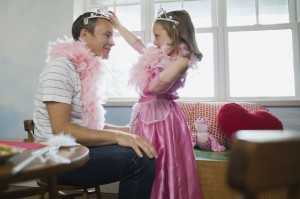
Source: Parent Dish
In our hyper-connected, media rich world, our kids are hit daily by thousands of images, sound bites, and peer interactions telling them what it means to be male or female, what their sexuality is supposed to look like, and how they are supposed to perform it – as well as how they are supposed to express their gender and what their identity is supposed to be and look like.
Every day, our children are shown the box they are expected to live inside of and are encouraged to shrink down the parts of themselves that don’t fit that narrow mold.
As adults, we sometimes forget how much gender messaging and gender policing goes on in the world.
We’ve built up our calluses, donned our strongest armor, put up our shields and numbed our sense of injustice. Many of us have forgotten all the pieces of ourselves that we sacrificed along the way in order to get by in society.
As parents, we have a responsibility to help our children discover their truest self and reach their fullest potential. They need our help to see that the labels we, as a society, have stuck to everything and everyone are half-truths at best and outright deceptions at worst.
All boys are not stronger, faster, braver than all girls. All girls are not kinder, gentler, more nurturing than all boys.
If we truly want our children to succeed in this world, they need our help to smash open the very boxes we’ve constructed for them – to claim their place, their voice, and their power.
Lucky for us, we have the ability to help them see through the lies, dismantle the traps, and rebuild the world to make room for their truths.
But how?
1. Help Break Down the Boxes They’re Trying to Fit Into
Help them see past the binary choices they are being offered – boy/girl, tomboy/girly-girl, jock/wimp, gay/straight, cis/trans.
Start by asking them to define the social box or stereotype they are feeling squeezed into, and then ask them to think about their friends, family, and admired media figures and see if anyone fits all the way into that definition.
By showing them all of the ways that their peers, family members, and people in the media fail to conform to such singular labels, they find room for themselves to stretch.
My youngest daughter was feeling pressured to claim the label “tomboy” even though it meant she would feel banned from wearing dresses. She had been told that she couldn’t be a “girly-girl” because she spent too much time playing with boys.
She was upset because she felt like her friends were rejecting her and failing to see all of her, that they were fixated on just the pieces of her that didn’t fit into their idea of what a girl should be like.
We talked about what those labels meant and who had created them. Then we talked about all of the people in her life, and I asked her to stick each one in one of those categories and make them fit perfectly.
It only took a couple of examples before she realized that no one fit – at least not without some serious soul surgery.
2. Encourage Your Kids to Think About All the Things They Love
They can even list, in writing, all of the things that they love doing, wearing, talking about – and all the people they enjoy doing those things with.
Celebrate their loves, passions, skills, and talents with them. Admire and cherish the things that make your child happy, that fulfill them, that make them special – all the things that poke out of the box.
Show them other people who enjoy similar things and have lived amazing lives doing those things while refusing to be put in a box.
My youngest daughter loves a movie called Fast Girls about a British relay-racing team because her most favorite thing is being the fastest runner in her class. When people (ahem, her PE teacher) tell her she shouldn’t compete with the boys, she just flashes to a scene in the movie where the girls take off their high heels to outrun a group of angry men, and then she kicks in her afterburners and leaves everyone in the dust.
Having just that one example of someone like her helps her to reject the criticism of people who want her to conform to their idea of who she should be.
3. Call Out and Name Gender Policing in the Media
Whether it’s the movies and TV shows your kids watch, the billboards you pass on the street, the books they read, or the music they listen to, children are absorbing all of those messages and internalizing them. Their world view is being constantly shaped by what they see around them.
I remember when my youngest asked, in her angry voice, “Mom, why does the prince always save the princess? It’s so boring. Why doesn’t she ever just save herself?”
She was four and already picking up on the gendered cues in the movies she watched and the books she read. Already frustrated with the limitations she saw them trying to place on her. Already starting to question and push those boundaries.
“Not always,” I told her and then went out and got her movies where the girl/princess saves the day and stories of awesome queens and other women who changed the world.
Now when we watch TV or read books together, we both call out stereotypes and talk about ways the writer could have changed it up and made it more realistic or offered a fresh point of view.
4. Create Safe Spaces
Doing this in your personal life so they can explore and experiment with the gender based messages they experience can help them immensely in deconstructing those messages.
At the start of summer, my family dropped off the grid, unplugged, and went camping for a week in the mountains of Colorado.
My youngest waited impatiently until we were hiking in the national forest to ask if it was safe for her to take her shirt off. When I said yes, she gleefully ripped off her shirt, climbed to the top of a rock and shouted, “Finally, I get to be a boy!”
My first internal reaction was, “No! You don’t have to be a boy to take your shirt off!”
My second reaction was to celebrate the freedom she was experiencing with her.
Because in her world, being topless and safe and non-sexual at the same time is something that is reserved for boys, and so in order to own that freedom in that moment, she claimed maleness. By joining her, I was able to show her that women, too, can have that freedom, even if it is currently limited to certain spaces.
Her dad also got to let his hair down, wear his pigtails and his lungi (an Asian style skirt). We talked about how men’s self-expression is also limited in our culture and the need to push back in both directions.
5. Help Them Expand the Safe Bubble by Being ‘Upstanders’
Remind your kids that as they stretch and claim their space in the world, they also need to be sure that they are not policing other people’s self-expression or limiting other people’s choices.
Just because your child has rejected a label does not mean it is an invalid choice for other people to make.
Encourage kids to stand up for their peers when they see them being policed by others, in the same way they wish to be supported when they refuse to conform.
Recently, my oldest overheard another girl calling her friend a slut. My daughter stepped in and asked, “Do you even know what that word means?” She gave the girl a brief rundown of the history of that word and cautioned her against using it. “Even if you’re joking when you say it, other people might not hear it that way and it can have real consequences.”
My youngest overheard her boyfriend calling another boy a “sissy crybaby” and went over to tell him that boys were allowed to cry when they got hurt or felt sad and that teasing another boy for it wasn’t okay.
She told him that she didn’t want to date him if he was going to pick on people or tell them how they had to behave. She reminded him of all the things she did that weren’t girly, and he still liked her, so why couldn’t this boy be himself and still be a good person and a good friend?
In both cases, the kids who were being insensitive took a minute to reflect and ultimately did the right thing, apologizing to the person they’d hurt and correcting their behavior. Even better, they spread the message to their friends.
6. Support Them When They Take to the Streets or Classrooms
Once we have created safe spaces in our homes and in our personal lives for our children to explore and experiment with the boxes – boundaries and gender lines that they see in the world around them – they will begin to discover what feels right for them.
They will begin to form their own identity, and as they do this, many of them will begin to chafe at the restraints they feel being imposed on them because of their gender.
They may ask for help or support to live more of their truth out loud – in public.
A friend of mine has a gender creative son. At home, he primarily wears skirts and dresses, but he never felt comfortable wearing those clothes in public. One day, he mused to his mom that he wished he could wear his favorite plaid skirt and blouse to school, just once.
Together, they brainstormed ways to make that happen in a safe way. They came up with the idea of a gender-swap day at school.
Together, they talked to the principal, the parent’s association, the teachers, and finally the students. They got some push-back, but mostly they got support. On the scheduled day, about 30 boys, including the principal, wore skirts to school, and a number of the girls wore slacks and ties.
Her son felt safe and respected. He had the opportunity to talk to some of his peers about why he liked wearing skirts, and some of them even agreed that it was fun and wished they could do it more often.
***
Helping our children identify, name, and push back against the gender barriers they experience in the world is a radical act of courage.
And every time we do it, whether it is in the safety of our homes or out in the larger world, we make a little more room for everyone to live a little more of their truth with a little less fear.
[do_widget id=”text-101″]
Want to discuss this further? Visit our online forum and start a post!
Bree Ervin is a feminist writer, political commentator and book reviewer at Think Banned Thoughts. Her proudest achievement is being the co-parent of two up and coming rabble rousers and remarkable young “upstanders” who are already working for social justice. Bree has a degree in history with a focus on comparative religion which she uses to dismantle the idea that patriarchy is the natural order and to poke holes in cultural ideas of static gender and sex-based binaries. She recently became a certified sexual health instructor and is debating whether she should go back to school to become an abortion provider, or become a politician in order to turn back the tide of reproductive restrictions sweeping the nation. When she’s not suited up in her ranty pants writing stories to inspire change, you can find her climbing mountains or stirring up smiles in the kitchen. You can follow her on twitter @thinkbanned or on Facebook/bannedthoughts.
Search our 3000+ articles!
Read our articles about:
Our online racial justice training
Used by hundreds of universities, non-profits, and businesses.
Click to learn more




















